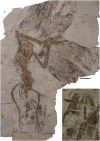Unique caudal plumage of Jeholornis and complex tail evolution in early birds
- PMID: 24101506
- PMCID: PMC3808668
- DOI: 10.1073/pnas.1316979110
Unique caudal plumage of Jeholornis and complex tail evolution in early birds
Abstract
The Early Cretaceous bird Jeholornis was previously only known to have a distally restricted ornamental frond of tail feathers. We describe a previously unrecognized fan-shaped tract of feathers situated dorsal to the proximal caudal vertebrae. The position and morphology of these feathers is reminiscent of the specialized upper tail coverts observed in males of some sexually dimorphic neornithines. As in the neornithine tail, the unique "two-tail" plumage in Jeholornis probably evolved as the result of complex interactions between natural and sexual selective pressures and served both aerodynamic and ornamental functions. We suggest that the proximal fan would have helped to streamline the body and reduce drag whereas the distal frond was primarily ornamental. Jeholornis reveals that tail evolution was complex and not a simple progression from frond to fan.
Keywords: Aves; Jehol; Mesozoic.
Conflict of interest statement
The authors declare no conflict of interest.
Figures



References
-
- Thomas ALR. On the tails of birds. Bioscience. 1997;47:215–225.
-
- Balmford A, Jones IL, Thomas ALR. How to compensate for sexually-selected tails: The evolution of sexual dimorphism in wing length in long-tailed birds. Evolution. 1994;48:1062–1070. - PubMed
-
- Zhou Z-H, Zhang F-C. Mesozoic birds of China: A synoptic review. Vertebr Palasiat. 2006;44:74–98.
-
- Zhou Z, Zhang F. Jeholornis compared to Archaeopteryx, with a new understanding of the earliest avian evolution. Naturwissenschaften. 2003;90(5):220–225. - PubMed
Publication types
MeSH terms
LinkOut - more resources
Full Text Sources
Other Literature Sources
Research Materials

